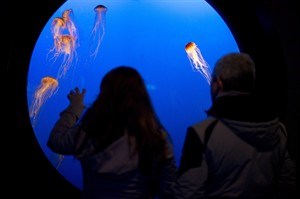
A visitors watch jellyfish at the Vancouver Aquarium in Vancouver, Thursday, Dec. 19, 2013. The facility just wrapped up its "Jelly Invasion" promotion, which included 17 species from around the globe, but the majority will remain in 2014. THE CANADIAN PRESS/Jonathan Hayward
December 23, 2013 - 5:00 AM
VANCOUVER - The jellyfish has drifted the seas for at least 650 million years and the boneless, brainless and heartless animals have become a major draw for the Vancouver Aquarium.
The facility just wrapped up its "Jelly Invasion" promotion, which included 17 species from around the globe, but the majority will remain in 2014.
"In previous years we've kind of gone through various states of jellies and no jellies. Definitely if they've ever gone away we have lots of people commenting because it's definitely one of the most popular exhibits," said marine biologist Mackenzie Neale.
Jellyfish are found in every ocean, from the surface to the deep sea. Large and often colourful, jellyfish are common in coastal zones worldwide.
They're also the oldest multi-organ animal known to man.
"I just find them intriguing because they're beautiful and they're so delicate and they've managed to survive for thousands and thousands of years ... practically longer than anything else. They range from deadly to not harmful at all," explained Neale.
Australia's box jelly is the most dangerous and has a lethal toxin more potent than cobra venom. It can kill a person in minutes.
"We don't have anything that's deadly now. We did have box jellies for about a month," Neale said.
"One of the ones we have is the largest in the world — it's the lion's mane jelly and it can deliver a strong sting, but none of the ones we have on display can kill you."
The lion's mane jellyfish has a bell that can reach 2.4 metres across and tentacles that extend over half the length of a football field.
Jellies swim by jet propulsion. The jelly will expand and then quickly contract its bell-shaped body, which forces water away from the bell and pushes the jelly in the opposite direction. But they're also extremely delicate, which can prove to be a challenge for those people taking care of them.
"Keeping them in aquariums is so challenging because in the wild they don't come in contact with anything really and here we have specialized tanks that we keep them in," Neale added.
"We try and keep them away from the walls because even just rubbing against acrylic, which is very, very smooth, can cause damage to them if they run into it repetitively. The same with cleaning and any handling."
The majority of the jellyfish can be produced at the Vancouver Aquarium. They can live in the polyp, or budding, stage for as long as five years or more.
"Most of the ones we culture ourselves. We can cause them to start a process called strobilation which produces the little baby jellyfish and we grow them right up to adulthood," Neale said
"We have polyps for most of the species and can grow them when we need more."
The Vancouver Aquarium has recorded one million visitors for the second year in a row and Neale likes to think the jellyfish contributed to that.
"It's been very popular."
———
If You Go ...
Vancouver Aquarium, www.vanaqua.org
Use your visit to stroll through Stanley Park.
News from © The Canadian Press, 2013